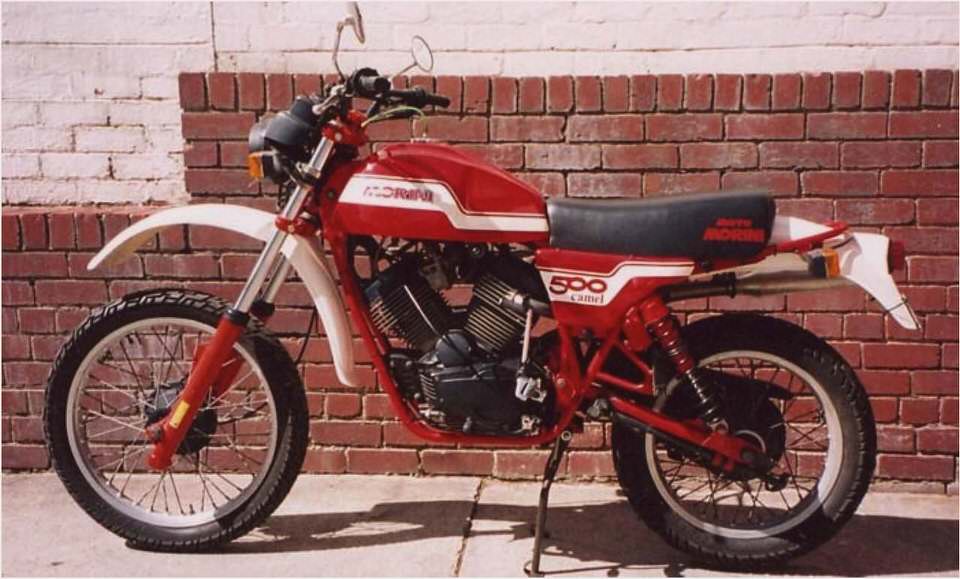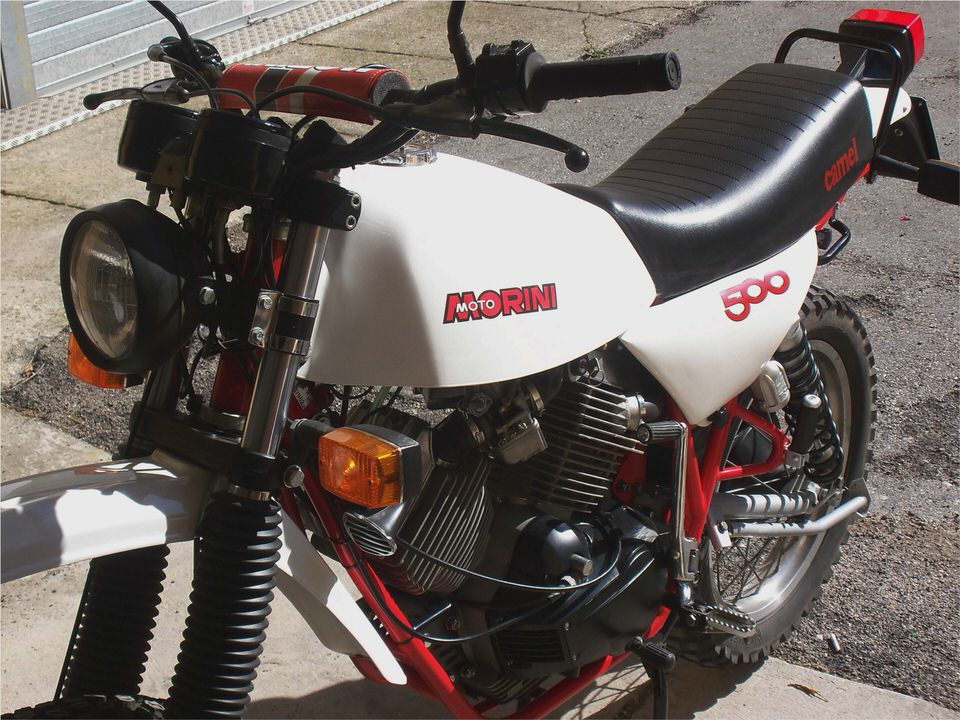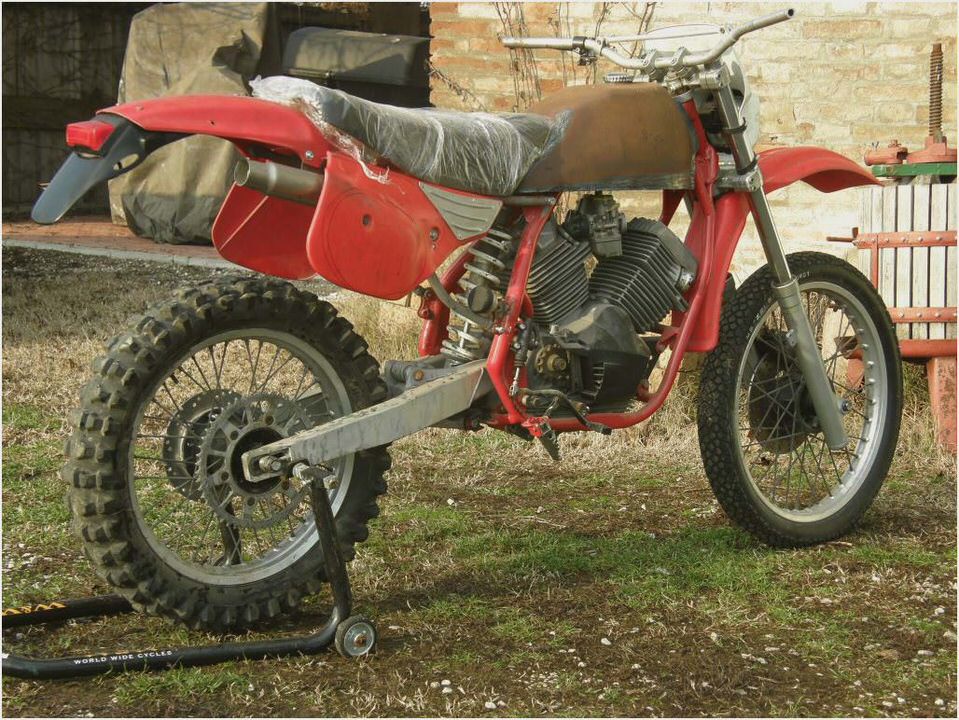
Ship of the Desert: the Moto Morini Camel
photo and story copyright
RC Herman
Crestone, CO
July 2011
Among the lilies of the field
Back in the days before computer programs designed machinery, before robots welded chassis together, before flawless engine castings were machined by automated CDC machine tools, motorcycles were designed and built by men. Passionate men, flawed men, motorcyclists. While I always have at least one modern bike in the shed, I keep a stable of interesting older machines, and these are the bikes that really make me smile.
This is the story of one of my favorites, a 1987 Moto Morini 501 Camel X3.
Moto Morini is a marque I knew of only by reputation until I met Eric Bergman, a fellow Norton owner with a few Morinis of his own. One of these is a Camel, Morini’s attempt to capitalize on the dual-sport craze resulting from the popularity of the famous Paris-Dakar Rally. Morini built the 500cc Camel (sold as Sahara in the UK market), and its 350cc sibling the Kanguro, using their trademark 72-degree V-twin with its unique Heron-Head design, which places the combustion chamber in the piston crown.
Eric’s bike is a 507cc 1987 X3 model, the final version of the Camel with square tube frame, Nigasil barrel liners, 6-speed gearbox and 21-liter Paris-Dakar fuel tank. I could easily have dismissed the bike as an oddity in this age of big modern “adventure bikes,” but in 2004 I did a 2000-mile tour with Eric and others, and the Camel proved itself a fine, capable machine.
Few of these machines ever made it to America’s shores, and I had never seen another. But Morinis have, to this day, a cult following of avid riders who appreciate this unique machine, and in the age of immediate communication and networking by email, when a Morini comes up for sale anywhere in the world, everyone in this esoteric cult instantly knows of it. So when Eric emailed me and mentioned that there was a beat up, non-running Camel X3 for sale in California (only 1200 miles away) I quickly contacted the owner and struck a deal.
In the dead of winter Eric and I headed west to retrieve my new steed. It was not love at first sight; the old warhorse clearly hadn’t been used gently. Nor had it been lovingly cared for. Wheeling it into the trailer, I was not certain that I had made a wise purchase.
Hauling the trailer home through the Rockies in a wild blizzard, I wondered if the gods were not mocking my impulsiveness. Would I ever become friends with this rare, well-scarred creature, or would this prove to be yet another foolish misadventure?
Back at home, my first task was to determine why the bike would not run. It took only a few minutes to find that there was no spark at either plug. There also was no battery, electric starter, or voltage regulator, but never mind that. Morini’s ignition scheme is a bit unusual and scooter-like, with a stator-mounted coil, a pair of transducers and an inductive pickup driven off the camshaft for timing.
Charging and lighting are handled by a separate bank of stator coils, a regulator and battery, but the ignition system is entirely independent of all that.
With the enthusiastic help of Morini email list members, I learned that it is common on these engines for the ignition coil to fail. Over time, the insulation on the very thin-gauge windings degrades, causing internal short circuits that dramatically reduce the coil’s output. Apparently some scooters (Vespa and the like) use an identical coil, so presumably replacements are available somewhere. I chose, instead, to wind my own.
A helpful Morini Club member in the Netherlands sent me a new plastic bobbin and I ordered a spool of transformer wire. After whittling a wooden spindle to hold the bobbin, I chucked it up in an electric drill and enlisted the help of my wife to hold the drill and keep it turning slowly as I fed wire to the bobbin. About 600 meters of 0.125mm transformer wire later, I had a new coil. A coating of epoxy to protect the windings, a bit of reassembly work and I kicked the starter lever through.
Spark, beautiful spark!
Still, the engine was reluctant to start. Finally it did run, but poorly. Rumor had it that the US-spec Dellorto carbs on these bikes never did work right, that Morinis would not breathe well with pod filters (one facing forward, one to the rear) and that modifications to the exhaust system would throw everything off. My Camel came to me with KN pod filters, a modified two-into-one exhaust and the original vilified 30mm carbs.
I tried everything I could think of, short of spending hundreds of dollars on new carburetors: a basic tune-up, replacing the pods with a stock airbox, fitting a tunable Supertrapp muffler. But still, the beast was difficult to start and ran poorly. Disgusted and defeated, I pushed the thing to a dusty corner of the shed.
For three years the Morini gathered dust, exiled into obscurity with several other “future projects.” Finally, in the fall of 2010 I pulled the Camel out of the cobwebs, determined that it would reach its potential and take its place among my favored rides. Well aware that this was a “now or never” moment, Eric loaded his own Camel and a box of Dellorto jets into his pickup truck and drove down to lend his support and expertise to my project.
Working together, we started with first principles: compression check, valve adjustment, spark test. With some effort, we got it running on the stand and did a dynamic timing adjustment. Then we turned our attention to intake and exhaust variables, trying various combinations of baffle plates in the muffler.
At some point, Eric noticed that the airbox assembly was missing one piece, a cylindrical shroud around the paper filter element. We located and installed that shroud, and while we had the carbs off, replaced the original #80 main jets with a pair of #75 jets from Eric’s kit.
I kicked the engine to life once again, and suddenly everything had changed. The Camel started easily, idled evenly and revved cleanly! With great anticipation, we rolled the bike off the work stand and I jumped on it for a quick test ride. Accelerating through all six gears, it was unbelievable!
Suddenly this beast had gone from a stubborn mule to a long-legged, energetic camel. The engine, with essentially no flywheel effect, revealed a revvy, tight-winding personality, like a strident, wiry little guy on too much coffee, his eyes bugged out, teeth gritted and the veins popping out on his forehead.
After a brief but exhilarating test run, I brought the bike back to the shed and rolled it back up on the work stand. It had seemed to run a perhaps slightly lean on the top, and I swapped out the #75 mains for #85s from Eric’s kit. Another quick test run revealed that #85 was too large. Once again, I dropped the bowls and installed the original #80s.
Back off the stand and into the street, and – ARGH! The engine sputtered, died and would not take more than half throttle! I limped back to the shed.
How could this be? #75 was too small, #85 too large, #80 wouldn’t run? It just did not make sense.
Out came the main jets. Yes, they both were clearly marked 80. I held them up to the light and looked through them while also looking through one of the 85s. ACK! One of my original “#80” jets had a hole drilled through it that could pass a small fish!

It probably was the equivalent of a #150 jet. Were the motorcycle gods playing a joke on me? The #75s went back in, and the engine ran just fine.
Now that I could see the Camel as a motorcycle, instead of a frustrating pile of junk, I tore into it with enthusiasm. Scrubbing off 23 years of crud, I found a broken motor mount bolt and a crack beginning in the frame, easily fixed. Wheels came off, bearings checked, cleaned, repacked. Surprise!
The speedometer cable had frozen up, and the worm gear in the front hub milled the teeth off the drive gear. Not any easy problem to fix, so I installed a bicycle speedometer.
Brakes were disassembled and cleaned, chocolate pudding in the reservoirs replaced with fresh brake fluid. Another surprise: the original 46-tooth rear sprocket had been replaced with a 40, a major change. Sprockets, chain and tires were ordered.
Fork seals were replaced along with fresh fork oil.
I then turned my attention to electrical issues. I had to fabricate a battery box, install a battery, voltage regulator and turn signals. As with most old motorcycles with a checkered history, there was a lot of cobbled wiring, with poorly executed connections, bad grounds, taped up splices.
Having learned the hard way that such shoddy electrical work always comes back to bite you, I carefully reworked all dodgy wiring.
With the new tires installed it was time for an extended test ride. I called one of my local friends, who was more than happy to take a day off and accompany me on my first Camel ride. We loaded up the Morini and my MZ Country 500 and trailered them out to one of my favorite off road riding areas, the canyons and rolling hills of Colorado’s San Luis Valley.
Dodging snow in the shady spots, we ran the two bikes across the landscape, the V-twin’s distinctive howl blending with the thumper’s low-pitched growl. After a couple hours of this fun, we reluctantly trailered the bikes and called it a day. A very satisfying day.
With its long suspension travel, strong, rigid chassis and high ground clearance, the Camel is happy on or off the road. On asphalt, it’s sure-footed and stable, and it feels quite at home when the pavement ends. Obviously the Camel is a bit large and heavy for tight, technical trails, but across open country it’s pure joy. An enthusiastic performer, the little v-twin gives its all and doesn’t seem to know its limits.
There’s plenty of power on tap between 4000 and 7000 RPM, and kept on the boil it responds eagerly to a twist of the wrist. Marzocchi dampers at each end take the bumps in stride, inspiring confidence and encouraging spirited riding on and off the road.
Now that it’s sorted, the Camel has become a favorite. Just like Eric said it would. The challenges and minor frustrations along the way have only cemented this bike’s place in the stable.
Every time I cast an eye in its direction, the Camel seems to say: “I’m ready. Let’s you and me go out and have some fun.”
At play in the mountains of Colorado
SIDEBAR: SOURCES OF PARTS AND INFORMATION


- Moto Morini : Wikis (The Full Wiki)
- Moto Morini Corsaro motorcycle review, motorcycles, motorbike reviews
- Retro: Moto Morini 500 Turbo RideApart
- 2009 Moto Morini Scrambler – Motorcyclist Magazine
- Silence is Golden – Moto Morini 350K Sport – Classic Motorcycle Review…
